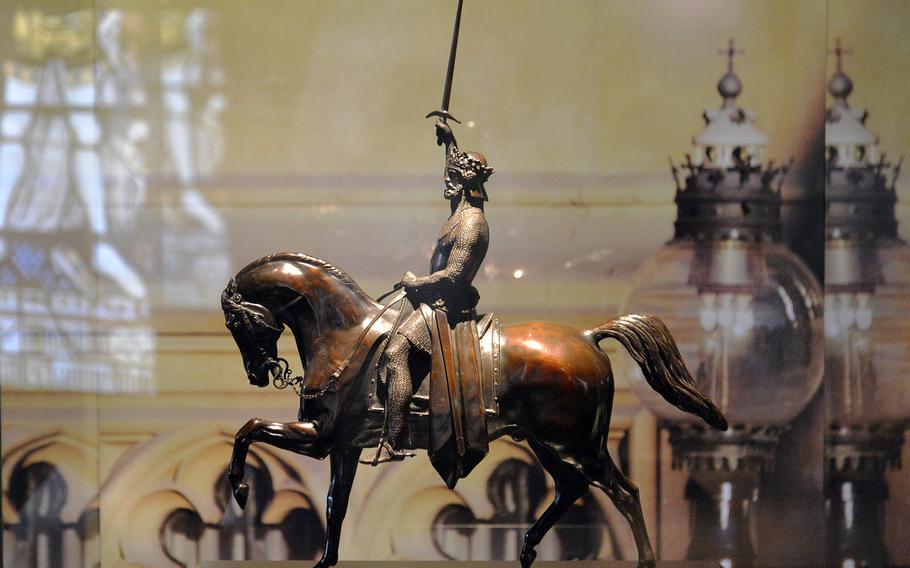
A statuette of Richard I of England, also known as the Lionheart. It is a miniaturized copy of the statue that stands in from of the Houses of Parliament in London. The statuette is on loan from Queen Elizabeth II to the exhibit ''Richard LionheartKing – Knight – Prisoner'' at the Historical Museum of the Palatinate in Speyer, Germany. (Michael Abrams/Stars and Stripes)
We all know that King Richard I showed up at the last minute to wed Robin Hood and Maid Marian. It was the ending of “Robin Hood: Prince of Thieves.”
But where the heck was he and why did he almost not make it?
A new exhibit, “Richard Lionheart King – Knight – Prisoner” at the Historical Museum of the Palatinate in Speyer, Germany, has the answers.
It seems that, on his way home from the Third Crusade, Richard was kidnapped by Duke Leopold V of Austria and German Emperor Heinrich VI and held for a ransom of 100,000 marks. At the time that was more than 25 tons of silver.
Held in Austria and Germany, he was released after more than a year and made his way back to England for the wedding.
Of course, the wedding didn’t really happen; that’s all Hollywood. But the exhibit covers the details of Richard’s life and legend with more than 150 objects borrowed from renowned museums, libraries and even the queen of England.
The exhibit is split into four parts. The first covers the people in power at the time of his birth, including his parents Henry II and Eleanor of Aquitaine. The second looks at Richard on the Crusade, the taking of Acre and his counterpart Saladin. The third delves into Richard’s captivity and how his ransom was raised. The last section looks at his return to England, his subsequent journey to France and his untimely death there in 1199.
Today, many people know Richard the Lionheart mostly through the Robin Hood movies, but once he was the most famous person of the Middle Ages. He worked on his own legend from the start. Like other English kings, he tried to trace his lineage back to King Arthur. He supposedly carried Arthur’s sword Excalibur into battle. A notable sword fighter, he led his men into battle from the front and not the rear. His nickname was evidently well-deserved.
Part of the Robin Hood story is true though. For example, John, also known as John Lackland, did try to usurp the throne while Richard was on his Crusade. And did inherit it upon Richard’s death.
Richard’s kingdom stretched from England through parts of France and Spain. Busy with the Crusades and languishing in captivity, he barely spent time in England.
Some of the interesting things to see at the exhibit are medieval books and documents, swords, helmets and other military gear a Crusader or knight would use. Also on display are copies of the tomb sculptures of Eleanor, Henry II and Richard himself. The exhibit is unfortunately only in German, but the audio guide that is free with the price of admission comes in an English version.
Fascinating is a 12th-century statue of a pilgrim and his wife. This is possibly a farewell scene, as he is wearing a cross on his tunic. Normally this would be removed when the journey to the Holy Land was complete.
An illustration from the medieval manuscript “Effigies ad Regem Angliae” shows the king’s imprisonment, release and death — he was mistakenly shot with a crossbow by one of his own men. Check out the lead box where his heart was once placed. Translated, the inscription on the top reads ‘’Here lies the heart of Richard, King of England.” It has since turned to dust.
One of the treasured objects on display is an original copy of the 1217 Magna Carta, an updated version of the original manuscript. One of only four copies, it was made for Henry III after John’s death.
The final object on display is a miniaturized copy of the statue of Richard the Lionheart that stands in from of the Houses of Parliament in London. On loan from Queen Elizabeth II.
abrams.mike@stripes.comTwitter: @stripes_photog
Das Historische Museum der Pfalz, Domplatz 4, 67346 Speyer, Germany.
The museum is just off the A61, across from the city’s cathedral. The large Festplatz parking lot is nearby.
Times: 10 a.m. to 6 p.m. Tuesdays to Sundays. The Richard the Lionheart exhibit runs from Sept. 17 to April 15, 2018.
Costs: Admission for adults is 14.50 euros (about $18) and 6.50 euros for children ages 6 and older. A family ticket costs 39 euros for two adults and two children; each additional child pays 4.50 euros. Parking at the lot costs 3 euros for the day. An audio guide is included in admission.
Food: The museum has a cafe/restaurant and there are restaurants nearby.
Information: The museum’s German language-only website is: museum.speyer.de
An accompanying exhibit about Robin Hood opens in November.
Make use of your day-long parking and visit the nearby Speyer Cathedral.